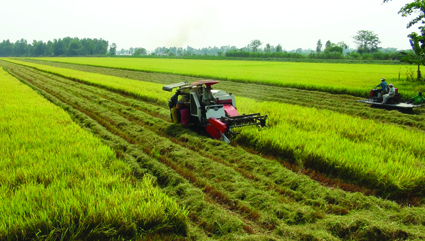Prof. Dr. Do Kim Chung and Dr. Kim Thi Dung
Vietnam National University of Agriculture
 |
| Harvesting 2014-2015 winter-spring rice crop in Dong Thap province__Photo: Phuc Hau/VNA |
Despite difficulties in 2014, the country’s agricultural sector has recorded a growth rate of 3.3 percent with export revenues of USD 30.8 billion and is undergoing a restructuring process towards better catering to the market demand. However, such development remains unstable because of weak competitiveness of a number of farm products, unstable consumption market, ineffective development of an agricultural value chain and low income of rural residents. This article suggests several solutions to the nation’s sustainable agricultural development in the coming time.
Achievements in agricultural development
After nearly 30 years of renewal, Vietnam’s agriculture has achieved a fast and stable growth rate for a long time with its structure shifting in the right direction. Agriculture is a source of livelihood for 9.53 million rural households and 68.2 percent of the country’s population (60 million people) and contributes 18-22 percent of the country’s GDP and 23-35 percent of the country’s export revenues. Although affected by economic downturn, agriculture was the sole sector enjoying a trade surplus in the 2010-2013 period. In 2014, the country’s agriculture, forestry and fisheries exports fetched USD 30.8 billion, a year-on-year rise of 11.2 percent, and gained a trade surplus of USD 9.5 billion. Staples recording high export revenues were coffee, up 32.2 percent; cashew nuts, 21.2 percent; pepper, 34.1 percent; vegetables and fruits, 34.9 percent; seafood, 18 percent; forestry and wooden furniture, 12.7 percent and rice (excluding cross-border trade), 5.3 percent. Ten farm produce topping the USD 1 billion export mark include rice, coffee, rubber, cashew nuts, pepper, cassava, vegetables and fruits, shrimps, tra fish and forest products. While other economic sectors are being affected by economic recession, the agricultural sector has surmounted its difficulties to record comprehensive results and a fairly high growth rate from 2.6 percent in 2012 and 2013 to 3.3 percent in 2014, marking its recovery and growth.
* Only subscribers can access the rest of this article.








